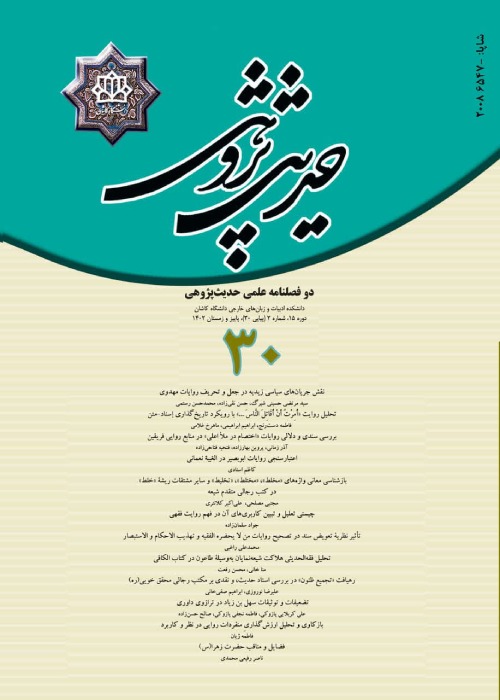The Isnad and Implication Examination of the Tradition "kjayrun linnisā’I an lāyarayna al-rejāl wa lāyarāhunna al-rijāl"
The tradition of "Good for Women" is one of the famous traditions that have been reported with various expressions in the historical, ethical and hadith texts of the two main Islamic Sects. However, in the conducted studies, despite the report of the tradition in various hadith texts, more attention has been paid to the implication of this tradition than to its Isnad validity. While this tradition is reported in the form of a "mursal" in most sources, and sometimes go with iḍṭirāb in the text. In the implication section, most of the researchers consider the tradition to refer to a special ruling about women and believe that women should avoid being in the community by dealing with activities related to housekeeping and raising children. While ignoring the authenticity of this hadith, if only the content of the tradition is considered, other views can be proposed about it, and women cannot be deprived of their right to social presence based on this report.
In this research, focusing on the reporting process of the tradition of "Good for Women" in the hadith sources of the two main Islamic Sects, the isnad status and its textual changes in different texts have been evaluated. In this regard, all the sources in which this tradition is narrated have been studied and analyzed. The Shiite sources in which the tradition is reflected are: "Da’ā’im alEslām", the book "Mūlid fāṭimah" or "Akhbār fāṭima", "Makārim Akhlāq alNabī wa alA’immah", "Manāqib ‘Āl Abiṭālib", "Makārim alAkhlāq", "Kashf alGhummah fī Marifat alA’immah". Among Sunni sources, this tradition can be seen in the books "Ḥlyat al-Awliya wa Ṭabaqāt al-Aṣfiya’", Iḥyā’ Ulūm alDīn", "Kanz al-Ummāl fī sunan alAqwāl wa al-Af’āl".
Research in hadith texts is one of the necessities for the correct understanding of jurisprudence and moral issues, which has always been the concern of Islamic thinkers in line with the detailed analysis of religious teachings. Generally, hadith scholars do not limit the final evaluation of hadiths to the examination of Isnad, but also consider it necessary to analyze hadiths in terms of text and content. Because neglecting each of them leads to misunderstandings and misconceptions of the Sunnah and the words of the Prophet (pbuh) and Imams (as). Among the notable traditions in the hadith texts that are found in Shia and Sunni hadith sources and various analyses have been made about them, is the hadith "kjayrun linnisā’I an lāyarayna al-rejāl wa lāyarāhunna al-rijāl" This tradition has been reported in different sources with different words and attributed to Ḥaḍrat Zahrā (as). The analyses presented around this hadith are so different that sometimes no common value can be found between them. For example, a group has concluded that women must not appear in the community but stay at home, only by addressing the words of this hadith. On the other hand, another group, emphasizing the weakness of the chain of transmission, considered the hadith to be invalid and rejected it.
The tradition of "Good for Women" is found neither in any of the four Main Shia hadith books nor in six authentic Sunni ones. Additionally, in most of the late hadith sources, it has been transmitted in the form of "mursal", without valid sanads. Furthermore, although some sources have presented the tradition as "musnad", most of their transmitters are accused of lying, fabricating hadiths, and falsification. After all, accepting the transmission of the hadith from the "Imam", it should also be noted that according to the literal meaning of the word "Ra’y", the meaning of "Ru’yah" is the staring and precise and lustful gaze of alien men and women at each other, not the fleeting and natural gaze that is common in social interactions. In addition, considering that a woman as a human being is responsible in social and political issues and it is not possible to deal with this responsibility except with a chaste presence that is in accordance with the laws of Islamic Sharia, and considering the practical life of Ḥaḍrat Zahrā (as) as a perfect role model of a responsible woman, it can be said that in this hadith she invited everyone, especially women, to observe hijab and chastity in the community, because Islam prefers the law-abiding presence of women in the community to their isolation
- حق عضویت دریافتی صرف حمایت از نشریات عضو و نگهداری، تکمیل و توسعه مگیران میشود.
- پرداخت حق اشتراک و دانلود مقالات اجازه بازنشر آن در سایر رسانههای چاپی و دیجیتال را به کاربر نمیدهد.



